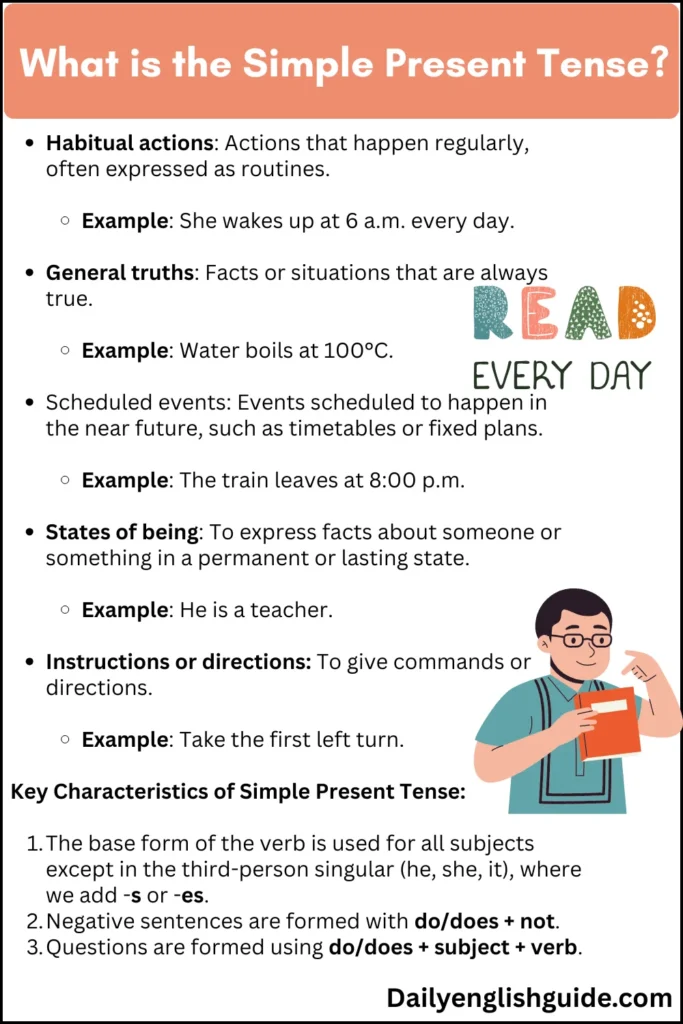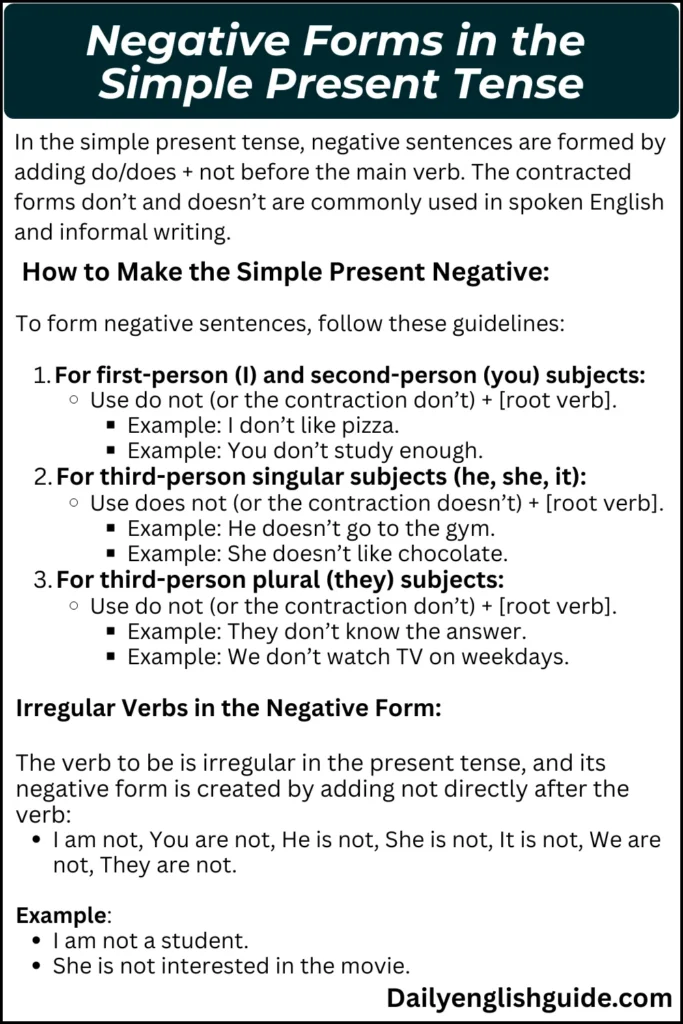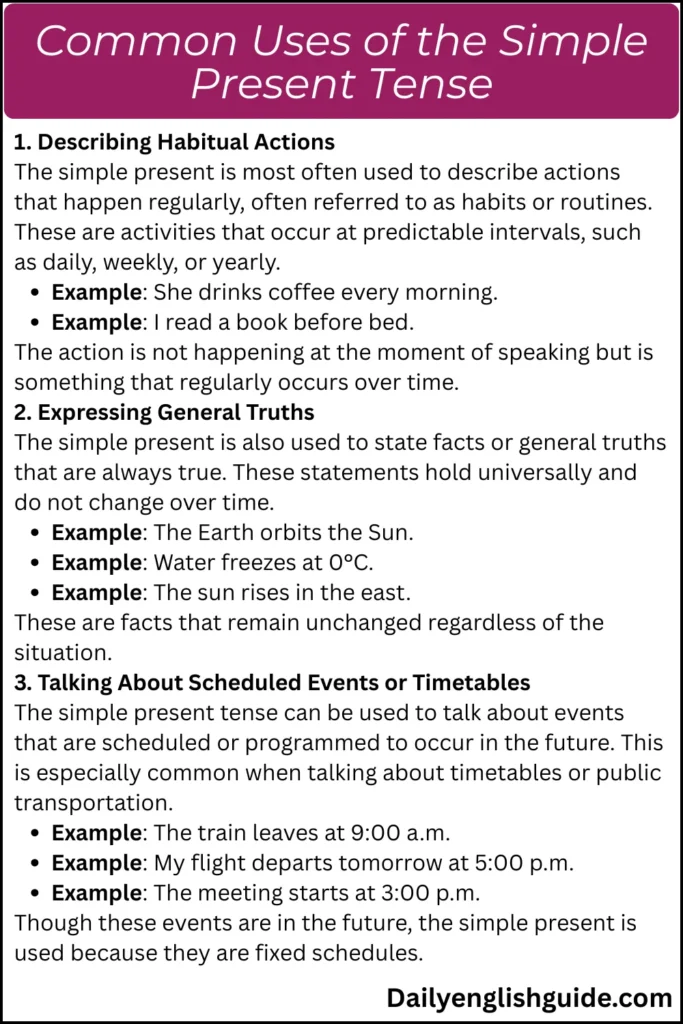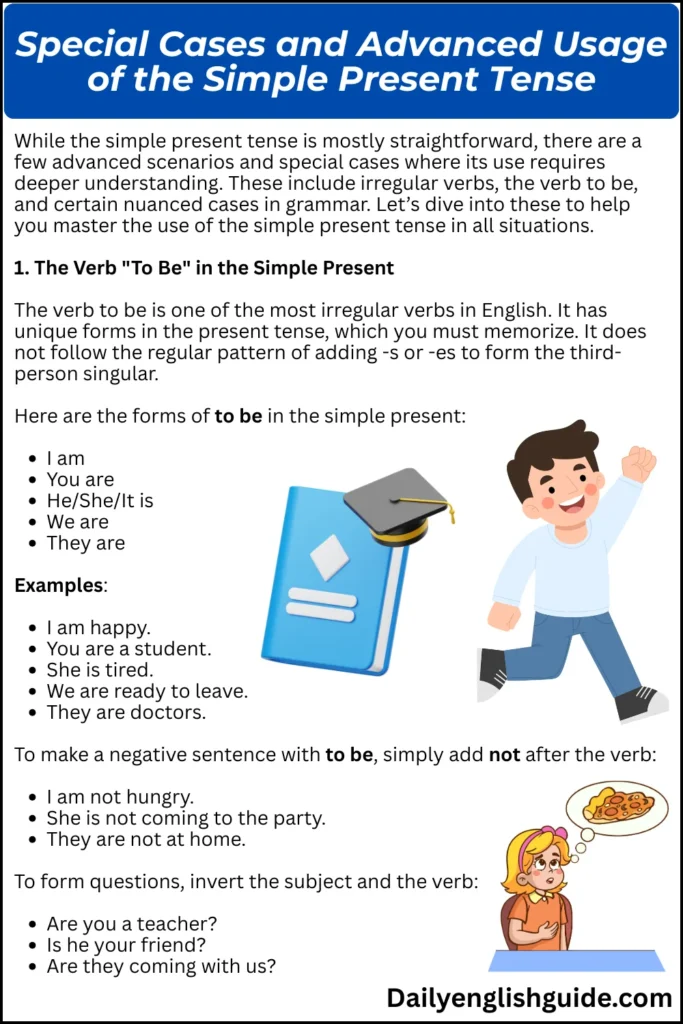The simple present tense is one of the most fundamental tenses in English, crucial for expressing daily activities, habitual actions, and general truths. It is commonly used in both spoken and written communication to discuss routines, facts, and things that are generally true. Whether you’re describing something that happens regularly or stating universal facts, mastering the simple present tense is vital for both beginners and advanced learners of English.
In this article, we will explore the formation, usage, and common mistakes associated with the simple present tense, providing you with everything you need to use it accurately and confidently in your writing and speaking.
What is the Simple Present Tense?
The simple present tense is used to talk about:
-
Habitual actions: Actions that happen regularly, often expressed as routines.
-
Example: She wakes up at 6 a.m. every day.
-
-
General truths: Facts or situations that are always true.
-
Example: Water boils at 100°C.
-
-
Scheduled events: Events scheduled to happen in the near future, such as timetables or fixed plans.
-
Example: The train leaves at 8:00 p.m.
-
-
States of being: To express facts about someone or something in a permanent or lasting state.
-
Example: He is a teacher.
-
-
Instructions or directions: To give commands or directions.
-
Example: Take the first left turn.
-
Key Characteristics of Simple Present Tense:
-
The base form of the verb is used for all subjects except in the third-person singular (he, she, it), where we add -s or -es.
-
Negative sentences are formed with do/does + not.
-
Questions are formed using do/does + subject + verb.

How to Form the Simple Present Tense
1. First-Person Singular (I) and Plural (We)
For the first person singular and plural, we use the root form of the verb:
-
I write, I go, We read, We play
In these cases, the verb remains unchanged.
2. Second-Person Singular (You) and Plural (You)
Similarly, for the second person singular and plural, we use the root form of the verb:
-
You write, You go, You eat
This rule applies regardless of whether “you” refers to one person or more.
3. Third-Person Singular (He, She, It)
For third-person singular subjects, add -s or -es to the base verb:
-
He writes, She goes, It rains
Note: For verbs ending in -o, -ch, -sh, -ss, -x, or -z, you add -es:
-
He watches, She goes
4. Third-Person Plural (They)
For third-person plural subjects, we use the root form of the verb:
-
They write, They play
There is no need to add -s or -es for plural subjects.

Negative Forms in the Simple Present Tense
In the simple present tense, negative sentences are formed by adding do/does + not before the main verb. The contracted forms don’t and doesn’t are commonly used in spoken English and informal writing.
How to Make the Simple Present Negative:
To form negative sentences, follow these guidelines:
-
For first-person (I) and second-person (you) subjects:
-
Use do not (or the contraction don’t) + [root verb].
-
Example: I don’t like pizza.
-
Example: You don’t study enough.
-
-
-
For third-person singular subjects (he, she, it):
-
Use does not (or the contraction doesn’t) + [root verb].
-
Example: He doesn’t go to the gym.
-
Example: She doesn’t like chocolate.
-
-
-
For third-person plural (they) subjects:
-
Use do not (or the contraction don’t) + [root verb].
-
Example: They don’t know the answer.
-
Example: We don’t watch TV on weekdays.
-
-
Irregular Verbs in the Negative Form:
The verb to be is irregular in the present tense, and its negative form is created by adding not directly after the verb:
-
I am not, You are not, He is not, She is not, It is not, We are not, They are not.
Example:
-
I am not a student.
-
She is not interested in the movie.
How to Ask a Question in the Simple Present
To form questions in the simple present tense, we typically use do/does + subject + root verb. Here’s how to make questions based on the subject:
-
For first-person (I) and second-person (you) subjects:
-
Use do + [subject] + [root verb].
-
Example: Do I look tired?
-
Example: Do you want to go to the party?
-
-
-
For third-person singular (he, she, it) subjects:
-
Use does + [subject] + [root verb].
-
Example: Does he like basketball?
-
Example: Does she study every day?
-
-
-
For third-person plural (they) subjects:
-
Use do + [subject] + [root verb].
-
Example: Do they live here?
-
Example: Do they work on weekends?
-
-

Common Uses of the Simple Present Tense
The simple present tense is used in several distinct contexts. Understanding these uses will help you apply this tense correctly in various situations. Below, we explore the most common uses of the simple present tense, along with examples for clarity.
1. Describing Habitual Actions
The simple present is most often used to describe actions that happen regularly, often referred to as habits or routines. These are activities that occur at predictable intervals, such as daily, weekly, or yearly.
-
Example: She drinks coffee every morning.
-
Example: I read a book before bed.
The action is not happening at the moment of speaking but is something that regularly occurs over time.
2. Expressing General Truths
The simple present is also used to state facts or general truths that are always true. These statements hold universally and do not change over time.
-
Example: The Earth orbits the Sun.
-
Example: Water freezes at 0°C.
-
Example: The sun rises in the east.
These are facts that remain unchanged regardless of the situation.
3. Talking About Scheduled Events or Timetables
The simple present tense can be used to talk about events that are scheduled or programmed to occur in the future. This is especially common when talking about timetables or public transportation.
-
Example: The train leaves at 9:00 a.m.
-
Example: My flight departs tomorrow at 5:00 p.m.
-
Example: The meeting starts at 3:00 p.m.
Though these events are in the future, the simple present is used because they are fixed schedules.
4. Expressing Instructions or Directions
The simple present tense is often used to give instructions or directions, especially in manuals, recipes, and guides.
-
Example: Turn left at the traffic light.
-
Example: Mix the ingredients and bake at 180°C for 30 minutes.
These sentences express a series of actions or steps that need to be followed, often in a specific order.
5. Stating Opinions or Feelings (with stative verbs)
Some verbs, known as stative verbs, are used in the simple present tense to describe opinions, feelings, or states of being. These verbs include believe, like, hate, love, prefer, know, and understand.
-
Example: I love this movie.
-
Example: She knows the answer.
-
Example: They believe in the power of hard work.
Unlike action verbs, stative verbs describe situations or emotions that are ongoing or permanent in nature.
6. Reporting News or Commentary (Journalistic Use)
In journalism, the simple present is often used to report news or commentary, particularly when giving live updates or ongoing reports.
-
Example: The company announces a new product today.
-
Example: Police report that the suspect is still at large.
These sentences convey facts as though they are happening right now, even if the events occurred earlier.
Common Mistakes to Avoid in the Simple Present Tense
Even though the simple present tense may seem straightforward, it is often misused in everyday conversation and writing. Below are some of the most common mistakes to watch out for, along with tips on how to avoid them:
1. Forgetting the Third-Person Singular Form
A common error is failing to add -s or -es for third-person singular subjects in the present tense.
-
Incorrect: He go to school every day.
-
Correct: He goes to school every day.
Always remember to add -s or -es to the verb when the subject is he, she, or it.
2. Using the Present Continuous Instead of Simple Present for Routines
The present continuous tense is used for actions that are happening at the moment of speaking, not for routines or habitual actions. Confusing the two is a frequent mistake.
-
Incorrect: I am going to the gym every day.
-
Correct: I go to the gym every day.
Use the simple present for regular, repeated actions, and reserve the present continuous for actions in progress.
3. Overusing “Do” in Negative Sentences
While do/does is required for negations, some learners may use do in the third-person singular form, which is incorrect.
-
Incorrect: She do not like tea.
-
Correct: She does not like tea.
Remember to use does not (or doesn’t) for third-person singular subjects.

Special Cases and Advanced Usage of the Simple Present Tense
While the simple present tense is mostly straightforward, there are a few advanced scenarios and special cases where its use requires deeper understanding. These include irregular verbs, the verb to be, and certain nuanced cases in grammar. Let’s dive into these to help you master the use of the simple present tense in all situations.
1. The Verb “To Be” in the Simple Present
The verb to be is one of the most irregular verbs in English. It has unique forms in the present tense, which you must memorize. It does not follow the regular pattern of adding -s or -es to form the third-person singular.
Here are the forms of to be in the simple present:
-
I am
-
You are
-
He/She/It is
-
We are
-
They are
Examples:
-
I am happy.
-
You are a student.
-
She is tired.
-
We are ready to leave.
-
They are doctors.
To make a negative sentence with to be, simply add not after the verb:
-
I am not hungry.
-
She is not coming to the party.
-
They are not at home.
To form questions, invert the subject and the verb:
-
Are you a teacher?
-
Is he your friend?
-
Are they coming with us?
2. Irregular Verbs in the Simple Present Tense
Irregular verbs in the present tense don’t follow the standard rules of conjugation. For example, the verb have becomes has in the third-person singular.
-
I have, You have, We have, They have
-
He/She/It has
Examples:
-
She has a cat.
-
They have a lot of work to do.
Other common irregular verbs include:
-
to do → does (third-person singular)
-
to go → goes (third-person singular)
-
to say → says (third-person singular)
-
to make → makes (third-person singular)
While many irregular verbs exist, the key to mastering their use in the simple present is consistent practice.
3. Non-Continuous Verbs
Certain verbs are rarely used in continuous tenses (like the present continuous). These are known as non-continuous verbs, and they are typically used in the simple present to describe states, feelings, emotions, perceptions, and preferences.
Some common non-continuous verbs include:
-
believe
-
know
-
like
-
understand
-
want
-
prefer
-
belong
-
seem
These verbs do not normally appear in continuous forms:
-
Correct: I like coffee.
-
Incorrect: I am liking coffee.
Examples of non-continuous verbs in the simple present:
-
She understands the problem.
-
I want to go home.
-
They know the answer.
4. Emphasizing Frequency with Adverbs
Adverbs of frequency help to clarify the regularity or frequency of an action. Common adverbs include always, usually, often, sometimes, rarely, and never.
These adverbs typically appear before the main verb (unless the verb is to be, where the adverb follows the verb):
-
I always wake up at 7 a.m.
-
She never drinks soda.
-
They sometimes play basketball after school.
-
We are always late for the meeting.
In questions or negatives, the adverb of frequency still appears before the main verb:
-
Do you always go to bed early?
-
She doesn’t usually eat breakfast.
Summary
The simple present tense is a versatile and essential tense used to describe habitual actions, general truths, scheduled events, and states of being. By mastering its formation, usage, and common mistakes, you will significantly improve your command of English grammar. Key points to remember are:
-
Use the root verb for most subjects; add -s or -es for third-person singular.
-
Form negative sentences with do/does + not.
-
Ask questions by inverting do/does with the subject.
-
Non-continuous verbs and the verb to be have special forms in the simple present.
With consistent practice, you will become more confident in using the simple present tense in both writing and speech.